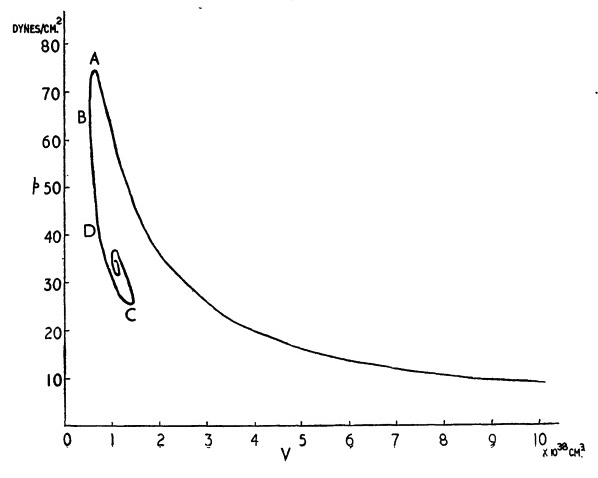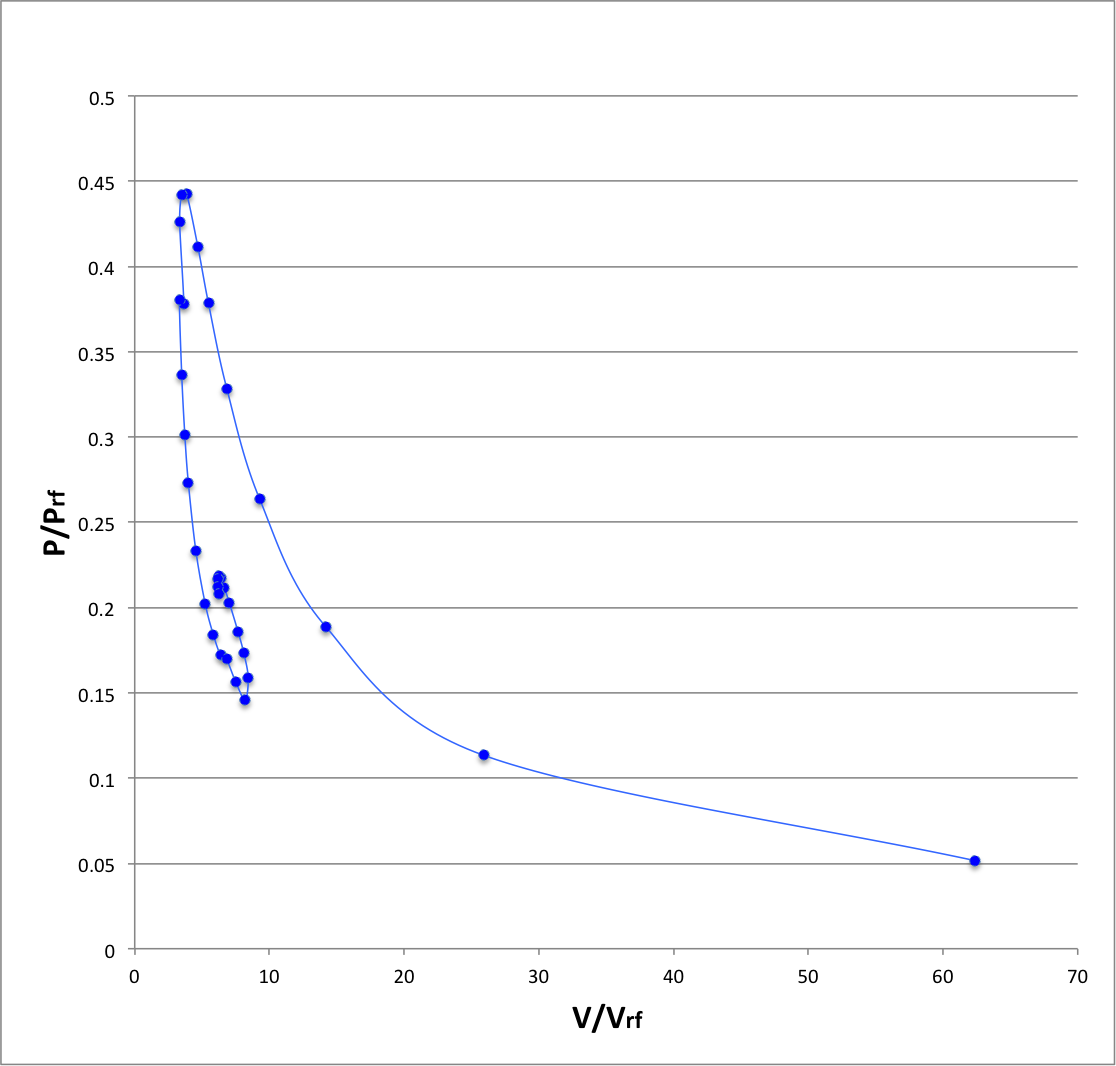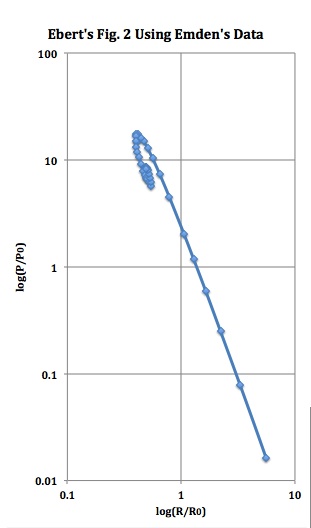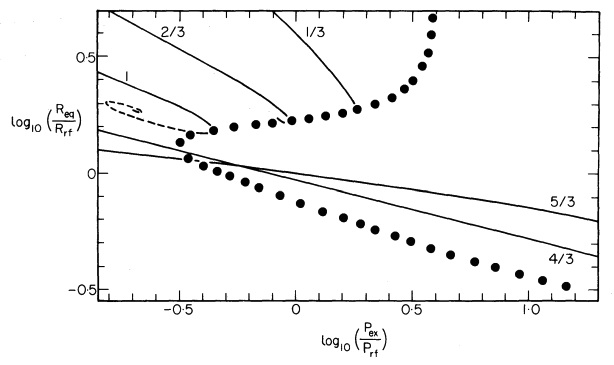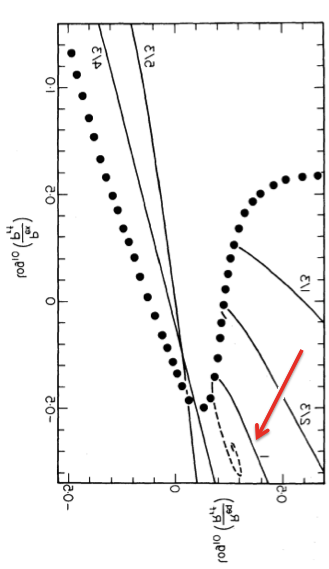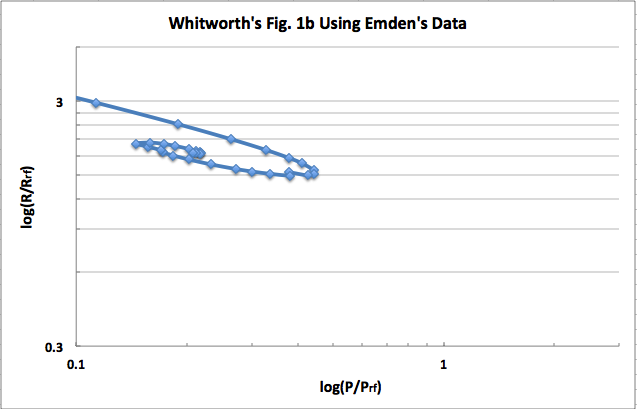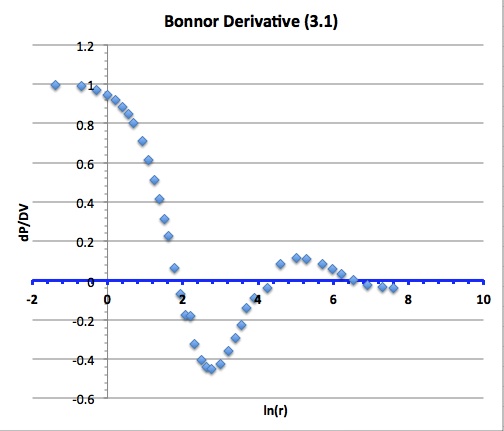Difference between revisions of "User:Tohline/SSC/Structure/BonnorEbert"
| (15 intermediate revisions by the same user not shown) | |||
| Line 2: | Line 2: | ||
=Pressure-Bounded Isothermal Sphere= | =Pressure-Bounded Isothermal Sphere= | ||
{{LSU_HBook_header}} | {{LSU_HBook_header}} | ||
As has been [[User:Tohline/SSC/Structure/IsothermalSphere#Isothermal_Sphere_(structure)|derived and discussed elsewhere]], an ''isolated'' isothermal sphere has a density profile that extends to infinity and, correspondingly, an unbounded total mass. In an astrophysical context, neither of these properties is desirable. A more realistic isothermal configuration can be constructed by embedding the structure in a low density, but hot external medium whose pressure, <math>P_e</math>, confines the isothermal configuration to a finite size. In a mathematical model, this can be accomplished by ripping off an outer layer of the ''isolated'' isothermal configuration down to the radius — label it <math>\xi_e</math> — at which the configuration's original (internal) pressure equals <math>P_e</math>; the interior of the configuration that remains — containing mass <math>M_{\xi_e}</math> — should be unaltered and in equilibrium. (This will work only for spherically symmetric configurations, as the gravitational acceleration at any location only depends on the mass contained inside that radius.) [http://adsabs.harvard.edu/abs/1955ZA.....37..217E Ebert] (1955) and [http://adsabs.harvard.edu/abs/1956MNRAS.116..351B Bonnor] (1956) are credited with constructing the first such models and, most significantly, discovering that, for any specified sound speed and applied external pressure, there is a mass above which no equilibrium configuration exists. We present, here, the salient elements of these (essentially equivalent) derivations. | As has been [[User:Tohline/SSC/Structure/IsothermalSphere#Isothermal_Sphere_(structure)|derived and discussed elsewhere]], an ''isolated'' isothermal sphere has a density profile that extends to infinity and, correspondingly, an unbounded total mass. In an astrophysical context, neither of these properties is desirable. A more realistic isothermal configuration can be constructed by embedding the structure in a low density, but hot external medium whose pressure, <math>~P_e</math>, confines the isothermal configuration to a finite size. In a mathematical model, this can be accomplished by ripping off an outer layer of the ''isolated'' isothermal configuration down to the radius — label it <math>~\xi_e</math> — at which the configuration's original (internal) pressure equals <math>~P_e</math>; the interior of the configuration that remains — containing mass <math>~M_{\xi_e}</math> — should be unaltered and in equilibrium. (This will work only for spherically symmetric configurations, as the gravitational acceleration at any location only depends on the mass contained inside that radius.) [http://adsabs.harvard.edu/abs/1955ZA.....37..217E Ebert] (1955) and [http://adsabs.harvard.edu/abs/1956MNRAS.116..351B Bonnor] (1956) are credited with constructing the first such models and, most significantly, discovering that, for any specified sound speed and applied external pressure, there is a mass above which no equilibrium configuration exists. We present, here, the salient elements of these (essentially equivalent) derivations. | ||
Prior to studying this discussion of pressure-bounded isothermal spheres, we recommend studying our [[User:Tohline/SSC/Structure/PolytropesEmbedded#n_.3D_5_Polytrope|related discussion of pressure-bounded {{User:Tohline/Math/MP_PolytropicIndex}} = 5 polytropes]]. As with isolated isothermal spheres, isolated {{User:Tohline/Math/MP_PolytropicIndex}} = 5 polytropes extend to infinity. But, unlike their isothermal counterparts, the structure of {{User:Tohline/Math/MP_PolytropicIndex}} = 5 polytropes is describable analytically. Hence, an analysis of their structure and its extension to pressure-bounded configurations avoids the clutter introduced by a model — such as the isothermal sphere — that can only be described numerically. As it turns out, the pressure-bounded {{User:Tohline/Math/MP_PolytropicIndex}} = 5 polytrope exhibits a ''Bonnor-Ebert'' type limiting mass that is analytically prescribable. Its derivation is mathematically quite clean and provides a firm foundation for understanding the better known — but only numerically prescribable — Bonnor-Ebert limiting mass. | Prior to studying this discussion of pressure-bounded isothermal spheres, we recommend studying our [[User:Tohline/SSC/Structure/PolytropesEmbedded#n_.3D_5_Polytrope|related discussion of pressure-bounded {{User:Tohline/Math/MP_PolytropicIndex}} = 5 polytropes]]. As with isolated isothermal spheres, isolated {{User:Tohline/Math/MP_PolytropicIndex}} = 5 polytropes extend to infinity. But, unlike their isothermal counterparts, the structure of {{User:Tohline/Math/MP_PolytropicIndex}} = 5 polytropes is describable analytically. Hence, an analysis of their structure and its extension to pressure-bounded configurations avoids the clutter introduced by a model — such as the isothermal sphere — that can only be described numerically. As it turns out, the pressure-bounded {{User:Tohline/Math/MP_PolytropicIndex}} = 5 polytrope exhibits a ''Bonnor-Ebert'' type limiting mass that is analytically prescribable. Its derivation is mathematically quite clean and provides a firm foundation for understanding the better known — but only numerically prescribable — Bonnor-Ebert limiting mass. | ||
| Line 16: | Line 16: | ||
</div> | </div> | ||
is the square of the isothermal sound speed. In their studies of ''pressure-bounded'' isothermal spheres, [http://adsabs.harvard.edu/abs/1955ZA.....37..217E Ebert] (1955, ZA, 37, 217) and [http://adsabs.harvard.edu/abs/1956MNRAS.116..351B Bonnor] (1956, MNRAS, 116, 351) both started with this governing ODE, but developed its solution in different ways. Here we present both developments while highlighting transformations between the two. | is the square of the isothermal sound speed. In their studies of ''pressure-bounded'' isothermal spheres, [http://adsabs.harvard.edu/abs/1955ZA.....37..217E Ebert] (1955, ZA, 37, 217) and [http://adsabs.harvard.edu/abs/1956MNRAS.116..351B Bonnor] (1956, MNRAS, 116, 351) both started with this governing ODE, but developed its solution in different ways. Here we present both developments while highlighting transformations between the two. | ||
<!-- | |||
NEW | |||
--> | |||
<div align="center"> | <div align="center"> | ||
<table border="1" cellpadding="4"> | <table border="1" cellpadding="4" width="80%"> | ||
<tr> | <tr> | ||
<td align="center">Derivation by [http://adsabs.harvard.edu/abs/1956MNRAS.116..351B Bonnor (1956)] (edited)</td> | <td align="center" width="40%">Derivation by [http://adsabs.harvard.edu/abs/1956MNRAS.116..351B Bonnor (1956)] (edited)</td> | ||
<td align="center">''translation''</td> | <td align="center" width="20%">''translation''</td> | ||
<td align="center">Derivation by [http://adsabs.harvard.edu/abs/1955ZA.....37..217E Ebert (1955)] (edited)</td> | <td align="center">Derivation by [http://adsabs.harvard.edu/abs/1955ZA.....37..217E Ebert (1955)] (edited)</td> | ||
</tr> | </tr> | ||
<tr> | <tr> | ||
<td align=" | <td align="left" rowspan="5"> | ||
[[File:BonnorDerivation01.jpg|300px|center|Bonnor (1956, MNRAS, 116, 351)]] | <!-- [[File:BonnorDerivation01.jpg|300px|center|Bonnor (1956, MNRAS, 116, 351)]] --> | ||
<!-- [[Image:AAAwaiting01.png|300px|center|Bonnor (1956, MNRAS, 116, 351)]] --> | <!-- [[Image:AAAwaiting01.png|300px|center|Bonnor (1956, MNRAS, 116, 351)]] --> | ||
<table border="0" align="center" cellpadding="8" width="100%"> | |||
<tr> | |||
<td align="center"> | |||
<math>~\frac{1}{r^2} \frac{d}{dr}\biggl(\frac{r^2}{\rho} \frac{d\rho}{dr}\biggr) = - \frac{4\pi Gm\rho}{kT} \, .</math> | |||
</td> | |||
<td align="right">(2.3)</td> | |||
</tr> | |||
</table> | |||
Let us now transform (2.3) by making the following substitutions: | |||
<table border="0" align="center" cellpadding="8" width="100%"> | |||
<tr> | |||
<td align="center"> | |||
<math>~\rho = \lambda e^{-\psi} \, ,</math> <math>r = \beta^{1 / 2} \lambda^{-1 / 2} \xi \, ,</math> | |||
</td> | |||
<td align="right">(2.6)</td> | |||
</tr> | |||
</table> | |||
where <math>~\lambda</math> is an arbitrary constant [we choose <math>~\lambda = \rho_c</math>], and | |||
<table border="0" align="center" cellpadding="8" width="100%"> | |||
<tr> | |||
<td align="center"> | |||
<math>~\beta = \frac{kT}{4\pi Gm} \, .</math> | |||
</td> | |||
<td align="right">(2.7)</td> | |||
</tr> | |||
</table> | |||
Then (2.3) becomes | |||
<table border="0" align="center" cellpadding="8" width="100%"> | |||
<tr> | |||
<td align="center"> | |||
<math>~\xi^{-2} \frac{d}{d\xi}\biggl(\xi^2 \frac{d\psi}{d\xi} \biggr) = e^{-\psi} \, .</math> | |||
</td> | |||
<td align="right">(2.8)</td> | |||
</tr> | |||
</table> | |||
</td> | </td> | ||
<td align="center"><math>G \Leftrightarrow \gamma</math></td> | <td align="center"><math>G \Leftrightarrow \gamma</math></td> | ||
<td align=" | <td align="left" rowspan="5"> | ||
[[File:EbertDerivation01.jpg|300px|center|Ebert (1955, ZA, 37, 217)]] | <!-- [[File:EbertDerivation01.jpg|300px|center|Ebert (1955, ZA, 37, 217)]] --> | ||
<!-- [[Image:AAAwaiting01.png|300px|center|Ebert (1955, ZA, 37, 217)]] --> | <!-- [[Image:AAAwaiting01.png|300px|center|Ebert (1955, ZA, 37, 217)]] --> | ||
<table border="0" align="center" cellpadding="8" width="100%"> | |||
<tr> | |||
<td align="center"> | |||
<math>~\ell_0 = \biggl(\frac{\Re T_0}{4\pi \mu \gamma \rho_0} \biggr)^{1 / 2} \, .</math> | |||
</td> | |||
<td align="right">(4)</td> | |||
</tr> | |||
</table> | |||
Wir setzen unter Verwendung von (4) <math>~r = \ell_0\xi</math> und <math>~\rho = \rho_0\eta</math> mit <math>~\rho_0 = \rho(0)</math>. Für <math>~\eta</math> ergibt sich die Differential-gleichung der isothermen Gaskugel: | |||
<table border="0" align="center" cellpadding="8" width="100%"> | |||
<tr> | |||
<td align="center"> | |||
<math>~\eta^{''} - \frac{(\eta^')^2}{\eta} + \frac{2\eta^'}{\xi} + \eta^2 = 0 \, .</math> | |||
</td> | |||
<td align="right">(17)</td> | |||
</tr> | |||
</table> | |||
Der Strich bezeichnet die Differentiation nach <math>~\xi</math>. | |||
</td> | </td> | ||
</tr> | </tr> | ||
| Line 64: | Line 130: | ||
In much of what follows, we will use Bonnor's <math>~(\xi, \psi)</math> notation rather than Emden's <math>~(\mathfrak{r}_1, v_1)</math> notation. This means that we will be referring to the ''isothermal Lane-Emden function'', <math>~\psi(\xi)</math>, which provides a solution to the governing, | In much of what follows, we will use Bonnor's <math>~(\xi, \psi)</math> notation rather than Emden's <math>~(\mathfrak{r}_1, v_1)</math> notation. This means that we will be referring to the ''isothermal Lane-Emden function'', <math>~\psi(\xi)</math>, which provides a solution to the governing, | ||
<div align="center"> | <div align="center"> | ||
<table border=" | <table border="0" cellpadding="8" align="center"> | ||
<tr><td align="center"> | <tr><td align="center"> | ||
Isothermal Lane-Emden Equation <p></p> | <font color="maroon">'''Isothermal Lane-Emden Equation'''</font> <p></p> | ||
{{ User:Tohline/Math/EQ_SSLaneEmden02 }} | {{ User:Tohline/Math/EQ_SSLaneEmden02 }} | ||
</td></tr> | </td></tr> | ||
| Line 176: | Line 242: | ||
Ebert chose to illustrate the behavior of the sequence of pressure-bounded isothermal spheres by plotting <math>~\log(P/P_0)</math> versus <math>~\log(R/R_0)</math>, rather than <math>~P</math> versus <math>~V</math>. The result — Figure 2 in [http://adsabs.harvard.edu/abs/1955ZA.....37..217E Ebert (1955)] — is reproduced here as the left-hand panel of our Figure 2. It should be clear that the ''information'' contained in Ebert's plot is identical to the ''information'' contained in the curve that is displayed in Bonner's P-V diagram. | Ebert chose to illustrate the behavior of the sequence of pressure-bounded isothermal spheres by plotting <math>~\log(P/P_0)</math> versus <math>~\log(R/R_0)</math>, rather than <math>~P</math> versus <math>~V</math>. The result — Figure 2 in [http://adsabs.harvard.edu/abs/1955ZA.....37..217E Ebert (1955)] — is reproduced here as the left-hand panel of our Figure 2. It should be clear that the ''information'' contained in Ebert's plot is identical to the ''information'' contained in the curve that is displayed in Bonner's P-V diagram. | ||
<div align="center" id=" | <div align="center" id="Fig2"> | ||
<table border="1" width="70%" cellpadding="8"> | <table border="1" width="70%" cellpadding="8"> | ||
<tr> | <tr> | ||
<td align="center" colspan="2"> | <td align="center" colspan="2"> | ||
'''Figure | '''Figure 2: Ebert's P-R Diagrams''' | ||
</td> | </td> | ||
</tr> | </tr> | ||
| Line 186: | Line 252: | ||
<td align="center" width="50%"> | <td align="center" width="50%"> | ||
<!-- [[File:EbertFig2Title.jpg|250px|center|Ebert (1955) Figure 2]] --> | <!-- [[File:EbertFig2Title.jpg|250px|center|Ebert (1955) Figure 2]] --> | ||
[[Image: | [[Image:AAAwaiting02.png|300px|center|Ebert (1955) Figure 2]]<br /> | ||
<div align="left">The reader may readily view this referenced image/text by opening (preferably in a separate browser window) the relevant article and scrolling to the relevant figure/page, as detailed immediately below.</div> | |||
</td> | </td> | ||
<td align="center" rowspan="1"> | <td align="center" rowspan="1"> | ||
| Line 213: | Line 280: | ||
</div> | </div> | ||
<div align="center" id=" | |||
<table border="1"> | In an effort to demonstrate more explicitly how Bonnor's 1956 work and Ebert's 1955 work tie back to the original work on isolated isothermal spheres that was published by Emden in 1907, the right-hand panel of our Figure 1 shows a plot of <math>~P_e/P_0</math> versus <math>~V/V_0</math>, and the right-hand panel of our Figure 2 shows a plot of <math>~\log(P_e/P_0)</math> versus <math>~\log(R/R_0)</math> that we have constructed using data drawn directly from [[User:Tohline/SSC/Structure/IsothermalSphere#Emden.27s_Numerical_Solution|Table 14 of Emden (1907)]]. | ||
===Whitworth's Normalization=== | |||
[http://adsabs.harvard.edu/abs/1981MNRAS.195..967W Whitworth] (1981, MNRAS, 195, 967) examined the behavior of model sequences that result from embedding polytropes with various effective adiabatic indexes <math>~(\gamma_g = 1/3,~ 2/3,~ 1,~ 4/3,~ 5/3)</math> in an external medium of pressure <math>~P_e</math>. Following Ebert's lead, in his Figure 1b, Whitworth showed how the size of the configuration varies with <math>~P_e</math> along each sequence. A reproduction of Whitworth's Figure 1b has been displayed [[User:Tohline/SSC/Structure/PolytropesEmbedded#WhitworthFig1b|in our separate discussion of pressure-bounded polytropic configurations that have analytic prescriptions]], but we have again displayed the figure here, in the right-most panel of our Figure 2, because Whitworth included pressure-bounded isothermal configurations <math>~(\gamma_g = 1)</math> among his models. The red arrow identifies the isothermal sequence. Whitworth's Figure 1b effectively serves as an extension of Ebert's Figure 2, shown above in the left-most panel of our Figure 2. In order to assist comparison with Ebert's figure, this time we have rotated and flipped Whitworth's figure relative to its original orientation because Whitworth chose to plot <math>~R</math> versus <math>~P_e</math> whereas Ebert plotted <math>~P_e</math> versus <math>~R</math>. | |||
<div align="center" id="Fig3"> | |||
<table border="1" width="80%"> | |||
<tr> | <tr> | ||
<td align="center" colspan="3"> | <td align="center" colspan="3"> | ||
'''Figure | '''Figure 3: Whitworth's P-R Diagrams''' | ||
</td> | </td> | ||
</tr> | </tr> | ||
<tr> | <tr> | ||
<td align="center"> | <td align="center" width="30%> | ||
[[File:WhitworthFig1bCopy.jpg| | [[File:WhitworthFig1bCopy.jpg|400px|center|Whitworth (1981) Figure 1b]] | ||
<!-- [[Image:AAAwaiting01.png|250px|center|Ebert (1955) Figure 2]] --> | <!-- [[Image:AAAwaiting01.png|250px|center|Ebert (1955) Figure 2]] --> | ||
</td> | </td> | ||
<td align="center" rowspan="2" width=" | <td align="center" rowspan="2" width="40%"> | ||
'''Pertaining to Reprinted Figure''' <br />(both on the top-left and on the right) | '''Pertaining to Reprinted Figure''' <br />(both on the top-left and on the right) | ||
<table border="0" align="center" cellpadding="2" width="90%"> | <table border="0" align="center" cellpadding="2" width="90%"> | ||
<tr><td align="right" width="25%">Author (year):</td><td align="left">[http://adsabs.harvard.edu/abs/ | <tr><td align="right" width="25%">Author (year):</td><td align="left">[http://adsabs.harvard.edu/abs/1981MNRAS.195..967W A. Whitworth (1981)]</td></tr> | ||
<tr><td align="right">Article Title.:</td><td align="left">'' | <tr><td align="right">Article Title.:</td><td align="left">''Global Gravitational Stability for One-Dimensional Polytropes''</td></tr> | ||
<tr><td align="right">Journal Title:</td><td align="left">'''Monthly Notices of the Royal Astronomical Society'''</td></tr> | <tr><td align="right">Journal Title:</td><td align="left">'''Monthly Notices of the Royal Astronomical Society'''</td></tr> | ||
<tr><td align="right">Volume & Pages:</td><td align="left">''' | <tr><td align="right">Volume & Pages:</td><td align="left">'''195''', pp. 967 - 977</td></tr> | ||
<tr><td align="right">Figure No.:</td><td align="left"> | <tr><td align="right">Figure No.:</td><td align="left">1b (p. 971)</td></tr> | ||
<tr><td align="right">Copyright:</td><td align="left">[https://ras.ac.uk Royal Astronomical Society] —</td></tr> | <tr><td align="right">Copyright:</td><td align="left">[https://ras.ac.uk Royal Astronomical Society] —</td></tr> | ||
<tr><td align="right"> </td><td align="left">Permission to reuse this figure has been granted implicitly as [[User:Tohline/Appendix/Images#MNRAS|summarized here]] and as [https://academic.oup.com/mnras/pages/rights_and_new_business_development detailed by the publisher here].</td></tr> | <tr><td align="right"> </td><td align="left">Permission to reuse this figure has been granted implicitly as [[User:Tohline/Appendix/Images#MNRAS|summarized here]] and as [https://academic.oup.com/mnras/pages/rights_and_new_business_development detailed by the publisher here].</td></tr> | ||
</table> | </table> | ||
<p></p> | <p></p> <p></p> <p></p> | ||
---- | ---- | ||
<p></p> | <p></p> | ||
| Line 242: | Line 316: | ||
<table border="0" cellpadding="2" align="center" width="90%"><tr><td align="center">'''Pertaining to Reprinted Figure''' (on the right)</td></tr> | <table border="0" cellpadding="2" align="center" width="90%"><tr><td align="center">'''Pertaining to Reprinted Figure''' (on the right)</td></tr> | ||
<tr><td align="left"> | <tr><td align="left"> | ||
Same as reprinted figure on the top-left, except image has been flipped vertically and horizontally so that the axes correspond with the axes of the diagrams presented above in our Figure 2a. | Same as reprinted figure on the top-left, except image has been flipped, both vertically and horizontally, so that the axes correspond with the axes of the diagrams presented above in our Figure 2a; a red arrow (our modification) points to the most relevant (isothermal) equilibrium sequence. | ||
</td></tr> | </td></tr> | ||
</table> | </table> | ||
| Line 251: | Line 325: | ||
<table border="0" cellpadding="2" align="center" width="90%"><tr><td align="center">'''Pertaining to Our Original Figure''' (on the bottom-left)</td></tr> | <table border="0" cellpadding="2" align="center" width="90%"><tr><td align="center">'''Pertaining to Our Original Figure''' (on the bottom-left)</td></tr> | ||
<tr><td align="left"> | <tr><td align="left"> | ||
Caption: In an effort to demonstrate more explicitly how | Caption: In an effort to demonstrate more explicitly how Whitworth's 1981 work ties back to the original work on isolated isothermal spheres that was published by Emden in 1907, the blue curve displays a plot of <math>~P_e/P_\mathrm{rf}</math> versus <math>~V/V_\mathrm{rf}</math> that we have constructed using data drawn directly from [[User:Tohline/SSC/Structure/IsothermalSphere#Emden.27s_Numerical_Solution|Table 14 of Emden (1907)]]. | ||
</td></tr> | </td></tr> | ||
</table> | </table> | ||
</td> | </td> | ||
<td align="center" rowspan="2"> | <td align="center" rowspan="2"> | ||
[[File: | [[File:WhitworthFig1bFlippedClipped.png|300px|center|Whitworth (1981) Figure 1b]] | ||
<!-- [[Image:AAAwaiting01.png|250px|center|Whitworth (1981) Figure 1b]] --> | <!-- [[Image:AAAwaiting01.png|250px|center|Whitworth (1981) Figure 1b]] --> | ||
</td> | </td> | ||
| Line 262: | Line 336: | ||
<tr> | <tr> | ||
<td align="center"> | <td align="center"> | ||
[[File:WhitworthFig1bUsingEmdenData.png| | [[File:WhitworthFig1bUsingEmdenData.png|300px|center|P-R Diagram Using Emden's (1907) data]] | ||
</td> | </td> | ||
</tr> | </tr> | ||
| Line 268: | Line 342: | ||
</div> | </div> | ||
It should be noted that the scaling adopted along both axes in Whitworth's Figure 1b is different from the scaling used by Ebert. As is detailed in the [[User:Tohline/SSC/Structure/PolytropesASIDE1|accompanying ASIDE]], Whitworth "referenced" <math>P_e</math> and <math>R</math> to, respectively, | It should be noted that the scaling adopted along both axes in Whitworth's Figure 1b is different from the scaling used by Ebert. As is detailed in the [[User:Tohline/SSC/Structure/PolytropesASIDE1|accompanying ASIDE]], Whitworth "referenced" <math>P_e</math> and <math>R</math> to, respectively, | ||
| Line 349: | Line 419: | ||
4.45 \biggl( \frac{c_s^6}{G^3 \rho_c} \biggr)^{1/2}\, .</math> | 4.45 \biggl( \frac{c_s^6}{G^3 \rho_c} \biggr)^{1/2}\, .</math> | ||
</div> | </div> | ||
Dividing this expression for <math>M_R</math> by the expression for <math>R</math> gives, | Dividing this expression for <math>~M_R</math> by the expression for <math>~R</math> gives, | ||
<div align="center"> | <div align="center"> | ||
<math> | <math> | ||
| Line 362: | Line 432: | ||
<span id="cychenMaryland"> | <span id="cychenMaryland"> | ||
Finally, using this relation to eliminate <math>\rho_c</math> from the expression for <math>~M_R</math> gives,</span> | Finally, using this relation to eliminate <math>~\rho_c</math> from the expression for <math>~M_R</math> gives,</span> | ||
<div align="center"> | <div align="center"> | ||
<table border="0" cellpadding="5"> | <table border="0" cellpadding="5"> | ||
| Line 421: | Line 491: | ||
==Mass versus Radius Equilibrium Sequence== | ==Mass versus Radius Equilibrium Sequence== | ||
===Old Derivation=== | |||
For use in a [[User:Tohline/SSC/Stability/InstabilityOnsetOverview#Isothermal|related discussion]], let's examine how the mass varies with radius — at fixed <math>~c_s^2</math> and fixed <math>~P_e</math> — in the limit as <math>~\xi_e \rightarrow 0</math>. From above, we have, | For use in a [[User:Tohline/SSC/Stability/InstabilityOnsetOverview#Isothermal|related discussion]], let's examine how the mass varies with radius — at fixed <math>~c_s^2</math> and fixed <math>~P_e</math> — in the limit as <math>~\xi_e \rightarrow 0</math>. From above, we have, | ||
<div align="center"> | <div align="center"> | ||
| Line 656: | Line 727: | ||
</table> | </table> | ||
</div> | </div> | ||
Now, we can also write, | |||
<div align="center"> | |||
<table border="0" cellpadding="5" align="center"> | |||
<tr> | |||
<td align="right"> | |||
<math>~\psi^' </math> | |||
</td> | |||
<td align="center"> | |||
<math>~=</math> | |||
</td> | |||
<td align="left"> | |||
<math>~\biggl(\frac{M}{m_0} \biggr) \xi^{-2} e^{-\psi/2}</math> | |||
</td> | |||
</tr> | |||
</table> | |||
</div> | |||
and, | |||
<div align="center"> | |||
<table border="0" cellpadding="5" align="center"> | |||
<tr> | |||
<td align="right"> | |||
<math>~e^{\psi} </math> | |||
</td> | |||
<td align="center"> | |||
<math>~=</math> | |||
</td> | |||
<td align="left"> | |||
<math>~\biggl(\frac{R}{r_0} \biggr) \xi^{-2} </math> | |||
</td> | |||
</tr> | |||
</table> | |||
</div> | |||
Hence, | |||
<div align="center"> | |||
<table border="0" cellpadding="5" align="center"> | |||
<tr> | |||
<td align="right"> | |||
<math>\frac{d\ln M}{d\ln R}</math> | |||
</td> | |||
<td align="center"><math>~=</math></td> | |||
<td align="left"> | |||
<math>~ | |||
\xi \biggl[ 2e^{-\psi} + \biggl(\frac{M}{m_0} \biggr)^2 \xi^{-4} e^{-\psi} \biggr]\biggl[ 2\biggl(\frac{M}{m_0} \biggr) \xi^{-2} e^{-\psi/2} + \xi \biggl(\frac{M}{m_0} \biggr)^2 \xi^{-4} e^{-\psi} \biggr]^{-1} | |||
</math> | |||
</td> | |||
</tr> | |||
<tr> | |||
<td align="right"> | |||
| |||
</td> | |||
<td align="center"><math>~=</math></td> | |||
<td align="left"> | |||
<math>~ | |||
\biggl[ 2\xi^4 + \biggl(\frac{M}{m_0} \biggr)^2 \biggr] | |||
\biggl[ 2\biggl(\frac{M}{m_0} \biggr) \biggl(\frac{R}{r_0} \biggr)^{1 / 2} + \biggl(\frac{M}{m_0} \biggr)^2 \biggr]^{-1} | |||
</math> | |||
</td> | |||
</tr> | |||
</table> | |||
</div> | |||
===New Derivation=== | |||
For use in a [[User:Tohline/SSC/Stability/InstabilityOnsetOverview#Isothermal|related discussion]], let's examine how the mass, <math>~M_R</math>, varies with radius, <math>~R</math>, at fixed <math>~c_s^2</math> and <math>~P_e</math>. From above, we have, | |||
<div align="center"> | |||
<table border="0" cellpadding="5" align="center"> | |||
<tr> | |||
<td align="right"> | |||
<math>~\frac{1}{\xi^2} \frac{d}{d\xi} \biggl[ \xi^2 \psi^' \biggr]</math> | |||
</td> | |||
<td align="center"> | |||
<math>~=</math> | |||
</td> | |||
<td align="left"> | |||
<math>~e^{-\psi}</math> | |||
</td> | |||
</tr> | |||
<tr> | |||
<td align="right"> | |||
<math>~\Rightarrow ~~~ | |||
\psi^{''} | |||
</math> | |||
</td> | |||
<td align="center"> | |||
<math>~=</math> | |||
</td> | |||
<td align="left"> | |||
<math>~ | |||
e^{-\psi} - \frac{2}{\xi} \psi^' | |||
\, , | |||
</math> | |||
</td> | |||
</tr> | |||
</table> | |||
</div> | |||
and, | |||
<div align="center"> | |||
<math>R^2 = \biggl( \frac{c_s^2}{4\pi G \rho_c} \biggr) \xi_e^2 </math> ;<br /> | |||
<p></p> | |||
<p></p> | |||
<math> | |||
M_R^2 = \biggl( \frac{c_s^6}{4\pi G^3 \rho_c} \biggr) \biggl[ \xi^2 \frac{d\psi}{d\xi} \biggr]^2_e \, . | |||
</math> | |||
</div> | |||
Given that, <math>P_e = (c_s^2 \rho_c) e^{-\psi_e}</math>, we can also write, | |||
<table border="0" cellpadding="5" align="center"> | |||
<tr> | |||
<td align="right"> | |||
<math>~R</math> | |||
</td> | |||
<td align="center"> | |||
<math>~=</math> | |||
</td> | |||
<td align="left"> | |||
<math>~\biggl( \frac{c_s^4}{4\pi G P_e} \biggr)^{1 / 2} \xi_e e^{-\psi_e/2} \, ,</math> | |||
</td> | |||
</tr> | |||
<tr> | |||
<td align="right"> | |||
<math>~M_R</math> | |||
</td> | |||
<td align="center"> | |||
<math>~=</math> | |||
</td> | |||
<td align="left"> | |||
<math>~\biggl( \frac{c_s^8}{4\pi G^3 P_e} \biggr)^{1 / 2} \biggl[ \xi^2 \psi^' \biggr]_e e^{-\psi_e/2} \, .</math> | |||
</td> | |||
</tr> | |||
</table> | |||
Hence, | |||
<div align="center"> | |||
<table border="0" cellpadding="5" align="center"> | |||
<tr> | |||
<td align="right"> | |||
<math>~\frac{dM_R}{d\xi_e}</math> | |||
</td> | |||
<td align="center"> | |||
<math>~=</math> | |||
</td> | |||
<td align="left"> | |||
<math>~\biggl( \frac{c_s^8}{4\pi G^3 P_e} \biggr)^{1 / 2} | |||
\biggl[ | |||
2\xi \psi^' | |||
+ \xi^2 \psi^{''} | |||
- \frac{1}{2} \xi^2 (\psi^')^2 | |||
\biggr]_e e^{-\psi_e/2} </math> | |||
</td> | |||
</tr> | |||
<tr> | |||
<td align="right"> | |||
| |||
</td> | |||
<td align="center"> | |||
<math>~=</math> | |||
</td> | |||
<td align="left"> | |||
<math>~\biggl( \frac{c_s^8}{4\pi G^3 P_e} \biggr)^{1 / 2} | |||
\biggl[ | |||
2\xi \psi^' | |||
+ \xi^2 \biggl( e^{-\psi_e} - \frac{2}{\xi_e} \psi_e^' \biggr) | |||
- \frac{1}{2} \xi^2 (\psi^')^2 | |||
\biggr]_e e^{-\psi_e/2} </math> | |||
</td> | |||
</tr> | |||
<tr> | |||
<td align="right"> | |||
| |||
</td> | |||
<td align="center"> | |||
<math>~=</math> | |||
</td> | |||
<td align="left"> | |||
<math>~\biggl( \frac{c_s^8}{4\pi G^3 P_e} \biggr)^{1 / 2} | |||
\biggl[ | |||
e^{-\psi_e} | |||
- \frac{1}{2} (\psi^')^2 | |||
\biggr]_e \xi_e^2 e^{-\psi_e/2} \, .</math> | |||
</td> | |||
</tr> | |||
</table> | |||
</div> | |||
Also, | |||
<div align="center"> | |||
<table border="0" cellpadding="5" align="center"> | |||
<tr> | |||
<td align="right"> | |||
<math>~\frac{dR}{d\xi_e}</math> | |||
</td> | |||
<td align="center"> | |||
<math>~=</math> | |||
</td> | |||
<td align="left"> | |||
<math>~ | |||
\biggl( \frac{c_s^4}{4\pi G P_e} \biggr)^{1 / 2} \biggl[ | |||
1 | |||
- \frac{1}{2} \xi_e \psi_e^' | |||
\biggr]e^{-\psi_e/2} | |||
\, .</math> | |||
</td> | |||
</tr> | |||
</table> | |||
</div> | |||
So the derivative of interest is, | |||
<div align="center"> | |||
<table border="0" cellpadding="5" align="center"> | |||
<tr> | |||
<td align="right"> | |||
<math>~\frac{dM}{dR} = \frac{dM/d\xi_e}{dR/d\xi_e}</math> | |||
</td> | |||
<td align="center"><math>~=</math></td> | |||
<td align="left"> | |||
<math>~ | |||
\biggl( \frac{c_s^8}{4\pi G^3 P_e} \biggr)^{1 / 2} | |||
\biggl[e^{-\psi_e}- \frac{1}{2} (\psi^')^2 \biggr]_e \xi_e^2 e^{-\psi_e/2} | |||
\biggl\{ | |||
\biggl( \frac{c_s^4}{4\pi G P_e} \biggr)^{1 / 2} \biggl[ 1 - \frac{1}{2} \xi_e \psi_e^' | |||
\biggr]e^{-\psi_e/2} | |||
\biggr\}^{-1} | |||
</math> | |||
</td> | |||
</tr> | |||
<tr> | |||
<td align="right"> | |||
| |||
</td> | |||
<td align="center"><math>~=</math></td> | |||
<td align="left"> | |||
<math>~ | |||
\biggl( \frac{c_s^4}{G^2} \biggr)^{1 / 2} | |||
\biggl[e^{-\psi_e}- \frac{1}{2} (\psi^')^2 \biggr]_e \xi_e^2 | |||
\biggl[ 1 - \frac{1}{2} \xi_e \psi_e^' | |||
\biggr]^{-1} | |||
</math> | |||
</td> | |||
</tr> | |||
<tr> | |||
<td align="right"> | |||
<math>~\Rightarrow~~~ \frac{d\ln M}{d\ln R} </math> | |||
</td> | |||
<td align="center"><math>~=</math></td> | |||
<td align="left"> | |||
<math>~\frac{\xi_e}{\psi^'} | |||
\biggl[e^{-\psi_e}- \frac{1}{2} (\psi^')^2 \biggr]_e | |||
\biggl[ 1 - \frac{1}{2} \xi_e \psi_e^' \biggr]^{-1} | |||
</math> | |||
</td> | |||
</tr> | |||
<tr> | |||
<td align="right"> | |||
| |||
</td> | |||
<td align="center"><math>~=</math></td> | |||
<td align="left"> | |||
<math>~\frac{\xi_e}{\psi^' e^{\psi_e}} | |||
\biggl[2 - (\psi^')^2 e^{\psi_e} \biggr]_e | |||
\biggl[ 2 - \xi_e \psi_e^' \biggr]^{-1} \, . | |||
</math> | |||
</td> | |||
</tr> | |||
</table> | |||
</div> | |||
Now, we can also write, | Now, we can also write, | ||
<div align="center"> | <div align="center"> | ||
Latest revision as of 03:34, 15 March 2019
Pressure-Bounded Isothermal Sphere

|
|---|
| | Tiled Menu | Tables of Content | Banner Video | Tohline Home Page | |
As has been derived and discussed elsewhere, an isolated isothermal sphere has a density profile that extends to infinity and, correspondingly, an unbounded total mass. In an astrophysical context, neither of these properties is desirable. A more realistic isothermal configuration can be constructed by embedding the structure in a low density, but hot external medium whose pressure, <math>~P_e</math>, confines the isothermal configuration to a finite size. In a mathematical model, this can be accomplished by ripping off an outer layer of the isolated isothermal configuration down to the radius — label it <math>~\xi_e</math> — at which the configuration's original (internal) pressure equals <math>~P_e</math>; the interior of the configuration that remains — containing mass <math>~M_{\xi_e}</math> — should be unaltered and in equilibrium. (This will work only for spherically symmetric configurations, as the gravitational acceleration at any location only depends on the mass contained inside that radius.) Ebert (1955) and Bonnor (1956) are credited with constructing the first such models and, most significantly, discovering that, for any specified sound speed and applied external pressure, there is a mass above which no equilibrium configuration exists. We present, here, the salient elements of these (essentially equivalent) derivations.
Prior to studying this discussion of pressure-bounded isothermal spheres, we recommend studying our related discussion of pressure-bounded <math>~n</math> = 5 polytropes. As with isolated isothermal spheres, isolated <math>~n</math> = 5 polytropes extend to infinity. But, unlike their isothermal counterparts, the structure of <math>~n</math> = 5 polytropes is describable analytically. Hence, an analysis of their structure and its extension to pressure-bounded configurations avoids the clutter introduced by a model — such as the isothermal sphere — that can only be described numerically. As it turns out, the pressure-bounded <math>~n</math> = 5 polytrope exhibits a Bonnor-Ebert type limiting mass that is analytically prescribable. Its derivation is mathematically quite clean and provides a firm foundation for understanding the better known — but only numerically prescribable — Bonnor-Ebert limiting mass.
Governing Relation
The equilibrium structure of an isolated isothermal sphere, as derived by Emden (1907), has been discussed elsewhere. From this separate discussion we appreciate that the governing ODE is,
<math>\frac{1}{r^2} \frac{d}{dr}\biggl( r^2 \frac{d\ln\rho}{dr} \biggr) =- \frac{4\pi G}{c_s^2} \rho \, ,</math>
where,
<math>c_s^2 = \frac{\Re T}{\bar{\mu}} = \frac{k T}{m_u \bar{\mu}} \, ,</math>
is the square of the isothermal sound speed. In their studies of pressure-bounded isothermal spheres, Ebert (1955, ZA, 37, 217) and Bonnor (1956, MNRAS, 116, 351) both started with this governing ODE, but developed its solution in different ways. Here we present both developments while highlighting transformations between the two.
| Derivation by Bonnor (1956) (edited) | translation | Derivation by Ebert (1955) (edited) | ||||||||||||
Let us now transform (2.3) by making the following substitutions:
where <math>~\lambda</math> is an arbitrary constant [we choose <math>~\lambda = \rho_c</math>], and
Then (2.3) becomes
|
<math>G \Leftrightarrow \gamma</math> |
Wir setzen unter Verwendung von (4) <math>~r = \ell_0\xi</math> und <math>~\rho = \rho_0\eta</math> mit <math>~\rho_0 = \rho(0)</math>. Für <math>~\eta</math> ergibt sich die Differential-gleichung der isothermen Gaskugel:
Der Strich bezeichnet die Differentiation nach <math>~\xi</math>. |
||||||||||||
| <math>\rho_c \Leftrightarrow \rho_0</math> | ||||||||||||||
| <math>\frac{kT}{m} \Leftarrow c_s^2 \Rightarrow \frac{\Re T_0}{\mu}</math> | ||||||||||||||
| <math>\beta^{1/2}\lambda^{-1/2} \Leftrightarrow l_0</math> | ||||||||||||||
| <math>e^{-\psi} \Leftrightarrow \eta</math> |
Both of these dimensionless governing ODEs — Bonnor's Eq. (2.8) and Ebert's Eq. (17) — are identical to the dimensionless expression derived by Emden (see the presentation elsewhere), namely,
<math> \frac{d^2v_1}{d\mathfrak{r}_1^2} +\frac{2}{\mathfrak{r}_1} \frac{dv_1}{d\mathfrak{r}_1} + e^{v_1} = 0 \, . </math>
The translation from Emden-to-Bonnor-to-Ebert is straightforward:
<math> \mathfrak{r}_1 = \xi|_\mathrm{Bonner} = \xi|_\mathrm{Ebert}~~~~\mathrm{and}~~~~e^{v_1} = e^{-\psi} = \eta \, . </math>
In much of what follows, we will use Bonnor's <math>~(\xi, \psi)</math> notation rather than Emden's <math>~(\mathfrak{r}_1, v_1)</math> notation. This means that we will be referring to the isothermal Lane-Emden function, <math>~\psi(\xi)</math>, which provides a solution to the governing,
Isothermal Lane-Emden Equation
|
P-V Diagram
Given a value for the isothermal sound speed, <math>~c_s</math>, and the central density, <math>~\rho_c</math>, our accompanying summary of the properties of an isothermal sphere, as derived by Emden (1907), provides the following structural relations:
- Radial Coordinate Position & Associated Volume:
<math>r = \biggl( \frac{c_s^2}{4\pi G \rho_c} \biggr)^{1/2} \xi </math> ;
<math>V \equiv \frac{4\pi}{3} r^3 = \frac{4\pi}{3} \biggl( \frac{c_s^2}{4\pi G \rho_c} \biggr)^{3/2} \xi^3 </math> ;
- Pressure Profile:
<math>P = (c_s^2 \rho_c) e^{-\psi}</math>;
- Enclosed Mass:
<math> M_r = \biggl( \frac{c_s^6}{4\pi G^3 \rho_c} \biggr)^{1/2} \biggl[ \xi^2 \frac{d\psi}{d\xi} \biggr] \, . </math>
Bonnor and Ebert both asked how the surface pressure of a truncated isothermal sphere of a given sound speed — or, equivalently, how the external pressure, <math>~P_e</math>, required to confine that truncated configuration — will vary with volume if the mass <math>~M_{\xi_e}</math> of the configuration, rather than the central density, is held fixed. The above expression for the enclosed mass can be inverted to give <math>~\rho_c</math> in terms of <math>~M_{\xi_e}</math>; specifically,
<math> \rho_c = \biggl( \frac{c_s^6}{4\pi G^3 M_{\xi_e}^2} \biggr) \biggl[ \xi^2 \biggl(\frac{d\psi}{d\xi}\biggr) \biggr]_e^2 \, , </math>
where the subscript <math>~e</math> denotes a truncated configuration of radius <math>~\xi_e</math> confined by an external pressure. This allows us to replace <math>~\rho_c</math> in favor of <math>~M_{\xi_e}</math> in the expressions for both the pressure and volume, obtaining,
- Pressure:
<math>P_e = \biggl( \frac{c_s^8}{4\pi G^3 M_{\xi_e}^2} \biggr) ~\xi_e^4 \biggl(\frac{d\psi}{d\xi}\biggr)^2_e e^{-\psi_e} \, ,</math>
- or, adopting Ebert's (1955) normalization pressure, <math>P_0 \equiv c_s^8/(4\pi G^3 M_{\xi_e}^2)</math> — see his equation (22),
<math>\frac{P_e}{P_0} = \xi_e^4 \biggl(\frac{d\psi}{d\xi}\biggr)^2_e e^{-\psi_e} \, ;</math>
- Volume:
<math>V^2 = \biggl( \frac{4\pi}{3} \biggr)^2 \biggl( \frac{c_s^2}{4\pi G} \biggr)^{3} \biggl( \frac{4\pi G^3 M_{\xi_e}^2}{c_s^6} \biggr)^3 \biggl[ \xi^2 \biggl(\frac{d\psi}{d\xi}\biggr) \biggr]_e^{-6} \xi_e^6 = \biggl( \frac{4\pi}{3} \biggr)^2 \biggl( \frac{G^6 M_{\xi_e}^6}{c_s^{12}} \biggr) \biggl[ \xi^2 \biggl(\frac{d\psi}{d\xi}\biggr) \biggr]_e^{-6} \xi_e^6 \, , </math>
<math> \Rightarrow ~~~~~ V = \frac{4\pi}{3} \biggl( \frac{G M_{\xi_e}}{c_s^{2}} \biggr)^3 \biggl[ \xi \biggl(\frac{d\psi}{d\xi}\biggr) \biggr]_e^{-3} \, ; </math>
- or, adopting a normalization volume, <math>V_0 \equiv (4\pi/3)R_0^3</math>, defined in terms of Ebert's (1955) normalization radius, <math>R_0 \equiv G M_{\xi_e}/c_s^2</math> — again, see his equation (22),
<math> \frac{V}{V_0} = \biggl[ \xi \biggl(\frac{d\psi}{d\xi}\biggr) \biggr]_e^{-3} \, ; </math>
- the corresponding normalized radius of the truncated configuration is,
<math> \frac{R}{R_0} = \biggl(\frac{V}{V_0}\biggr)^{1/3} = \biggl[ \xi \biggl(\frac{d\psi}{d\xi}\biggr) \biggr]_e^{-1} \, . </math>
The expressions shown here for <math>~P_e</math> and <math>~V</math> are identical to those presented by Bonnor (1956) for "<math>~p</math>" and "<math>~V</math>," immediately following his equation (2.17). They are also the set of parametric equations that lead to Bonnor's Fig. 1 P-V diagram, which is reproduced here as the left-hand panel of our Figure 1 (with permission, as our caption to this figure documents).
|
Figure 1: Bonnor's P-V Diagram |
|||||||||||||||
|
Pertaining to Reprinted Figure (immediately above)
|
Pertaining to Our Original Figure (immediately above)
Caption: In an effort to demonstrate more explicitly how Bonnor's 1956 work ties back to the original work on isolated isothermal spheres that was published by Emden in 1907, the blue curve in the above panel displays a plot of <math>~P_e/P_0</math> versus <math>~V/V_0</math> that we have constructed using data drawn directly from Table 14 of Emden (1907). |
||||||||||||||
Ebert chose to illustrate the behavior of the sequence of pressure-bounded isothermal spheres by plotting <math>~\log(P/P_0)</math> versus <math>~\log(R/R_0)</math>, rather than <math>~P</math> versus <math>~V</math>. The result — Figure 2 in Ebert (1955) — is reproduced here as the left-hand panel of our Figure 2. It should be clear that the information contained in Ebert's plot is identical to the information contained in the curve that is displayed in Bonner's P-V diagram.
|
Figure 2: Ebert's P-R Diagrams |
|||||||||||||||
|
The reader may readily view this referenced image/text by opening (preferably in a separate browser window) the relevant article and scrolling to the relevant figure/page, as detailed immediately below.
|
|||||||||||||||
|
Pertaining to Reprinted Figure (immediately above)
|
Pertaining to Our Original Figure (immediately above)
Caption: In an effort to demonstrate more explicitly how Ebert's 1955 work ties back to the original work on isolated isothermal spheres that was published by Emden in 1907, the blue curve in the above panel displays a plot of <math>~\log(P_e/P_0)</math> versus <math>~\log(R/R_0)</math> that we have constructed using data drawn directly from Table 14 of Emden (1907). |
||||||||||||||
In an effort to demonstrate more explicitly how Bonnor's 1956 work and Ebert's 1955 work tie back to the original work on isolated isothermal spheres that was published by Emden in 1907, the right-hand panel of our Figure 1 shows a plot of <math>~P_e/P_0</math> versus <math>~V/V_0</math>, and the right-hand panel of our Figure 2 shows a plot of <math>~\log(P_e/P_0)</math> versus <math>~\log(R/R_0)</math> that we have constructed using data drawn directly from Table 14 of Emden (1907).
Whitworth's Normalization
Whitworth (1981, MNRAS, 195, 967) examined the behavior of model sequences that result from embedding polytropes with various effective adiabatic indexes <math>~(\gamma_g = 1/3,~ 2/3,~ 1,~ 4/3,~ 5/3)</math> in an external medium of pressure <math>~P_e</math>. Following Ebert's lead, in his Figure 1b, Whitworth showed how the size of the configuration varies with <math>~P_e</math> along each sequence. A reproduction of Whitworth's Figure 1b has been displayed in our separate discussion of pressure-bounded polytropic configurations that have analytic prescriptions, but we have again displayed the figure here, in the right-most panel of our Figure 2, because Whitworth included pressure-bounded isothermal configurations <math>~(\gamma_g = 1)</math> among his models. The red arrow identifies the isothermal sequence. Whitworth's Figure 1b effectively serves as an extension of Ebert's Figure 2, shown above in the left-most panel of our Figure 2. In order to assist comparison with Ebert's figure, this time we have rotated and flipped Whitworth's figure relative to its original orientation because Whitworth chose to plot <math>~R</math> versus <math>~P_e</math> whereas Ebert plotted <math>~P_e</math> versus <math>~R</math>.
|
Figure 3: Whitworth's P-R Diagrams |
||||||||||||||||||||
|
Pertaining to Reprinted Figure
|
||||||||||||||||||||
It should be noted that the scaling adopted along both axes in Whitworth's Figure 1b is different from the scaling used by Ebert. As is detailed in the accompanying ASIDE, Whitworth "referenced" <math>P_e</math> and <math>R</math> to, respectively,
<math>~P_\mathrm{rf} = \biggl( \frac{3^4\cdot 5^3}{2^8} \biggr) P_0 \, ,</math>
<math> ~R_\mathrm{rf} = \biggl( \frac{2^2}{3\cdot 5} \biggr) R_0 \, . </math>
In generating the right-hand panel of our Figure 1, we have adopted Whitworth's scaling. That is to say, we have plotted <math>~P_e/P_\mathrm{rf}</math> versus <math>~V/V_\mathrm{rf}</math>, where,
|
<math>~\frac{P_e}{P_\mathrm{rf}}</math> |
<math>~=</math> |
<math>~\frac{P_e}{P_0} \cdot \frac{P_0}{P_\mathrm{rf}} = \biggl( \frac{2^8}{3^4\cdot 5^3} \biggr)\xi_e^4 \biggl(\frac{d\psi}{d\xi}\biggr)^2_e e^{-\psi_e} \, ,</math> |
and,
|
<math>~\frac{V}{V_\mathrm{rf}}</math> |
<math>~=</math> |
<math>~\frac{V}{V_0} \biggl( \frac{R_0}{R_\mathrm{rf}}\biggr)^{3} = \biggl( \frac{3\cdot 5}{2^2} \biggr)^3 \biggl[ \xi \biggl(\frac{d\psi}{d\xi}\biggr) \biggr]_e^{-3} \, .</math> |
Limiting Pressure and Maximum Mass
No matter how you look at the bounded isothermal sphere sequence — whether plotted as a curve in Bonnor's P-V diagram or as a curve in Whitworth's R-P diagram — it is clear that, for a given choice of the sound speed and the mass, there is a value of the pressure above which no equilibrium configuration exists. (Alternatively, for a given sound speed and external pressure, there is a limiting mass above which no equilibrium configuration exists; see below.) The configuration identifying this limiting pressure resides at the position along Bonnor's P-V diagram sequence where <math>~dP_e/dV</math> — or, in Whitworth's discussion, <math>~dP_e/dR</math> — first goes to zero.
Following Bonnor's Presentation
As is shown in his equation (3.1), Bonnor (1956) determined that, at a fixed mass and sound speed, <math>~dP/dV</math> goes to zero when,
<math>~1-\frac{1}{2} e^{\psi} \biggl( \frac{d\psi}{d\xi}\biggr)^2 = 0 \, .</math>
In the following figure, the function defined by the left-hand-side of this expression is plotted versus <math>~\ln\xi</math> using Emden's (1907) tabulated data. As Bonnor noted, the function first crosses zero when <math>~\xi \approx 6.5</math> <math>~(\ln\xi = 1.87)</math>.
An isothermal sphere that is truncated at this location will have a radius,
<math> R = \biggl( \frac{c_s^2}{G\rho_c} \biggr)^{1/2} \frac{6.5}{\sqrt{4\pi}} = 1.83 \biggl( \frac{c_s^2}{G\rho_c} \biggr)^{1/2} \, , </math>
which matches equation (3.3) of Bonnor (1956); and, drawing on function values provided in Emden's (1907) Table 14, it will have a total mass,
<math>~M_R = \biggl( \frac{c_s^6}{4\pi G^3 \rho_c} \biggr)^{1/2} \biggl[\xi^2 \frac{d\psi}{d\xi} \biggr]_e \approx \biggl( \frac{c_s^6}{G^3 \rho_c} \biggr)^{1/2} \biggl[ \frac{(14.353+17.214)/2}{\sqrt{4\pi}} \biggr] = 4.45 \biggl( \frac{c_s^6}{G^3 \rho_c} \biggr)^{1/2}\, .</math>
Dividing this expression for <math>~M_R</math> by the expression for <math>~R</math> gives,
<math> \frac{M_R}{R} = 2.43 \biggl( \frac{c_s^2}{G} \biggr) \, , </math>
which matches equation (3.6) of Bonnor (1956). In order to maintain an equilibrium structure while truncating the isothermal model at this radius requires applying an external pressure of the following magnitude:
<math>P_e = c_s^2 \rho_c e^{-\psi} \approx c_s^2 \rho_c (0.08493 + 0.05833)/2 = 0.0716~ c_s^2 \rho_c \, ,</math>
where, again, numerical values have been drawn from Emden's (1907) Table 14.
Finally, using this relation to eliminate <math>~\rho_c</math> from the expression for <math>~M_R</math> gives,
|
<math>~M_R</math> |
= |
<math>\biggl( \frac{c_s^8}{G^3 P_e} \biggr)^{1/2}\biggl[ \frac{1}{4\pi}\biggr]^{1/2} \biggl[\xi^2 e^{\psi/2} \biggl(\frac{d\psi}{d\xi} \biggr) \biggr]_e</math> |
|
|
<math>\approx</math> |
<math> \biggl( \frac{c_s^8}{G^3 P_e} \biggr)^{1/2} \frac{1}{2\pi^{1/2}} \biggl\{ \frac{1}{2} \biggl[ 14.353 (0.08493)^{1/2} + 17.214 (0.05833)^{1/2} \biggr] \biggr\} </math> |
|
|
<math>\approx</math> |
<math> 1.18 \biggl( \frac{c_s^8}{G^3 P_e} \biggr)^{1/2} \, . </math> |
This is the mass upper limit for a stable, pressure-bounded isothermal sphere — the so-called Bonnor-Ebert mass; see, for example, equation (1) of Shu (1977). In a separate discussion, we compare this result to the determinations of other related mass upper-limits.
Ebert's Corresponding Presentation
The expression derived by Bonnor for the ratio <math>~M_R/R</math> in the limiting configuration can be inverted to give,
<math> ~R \approx 0.41 \biggl( \frac{G M_R}{c_s^2} \biggr) \, . </math>
This matches the expression for the critical radius, <math>~R_\mathrm{kr}</math>, that appears as equation (23) in Ebert's (1955) published derivation. Similarly, the above relation that expresses the Bonnor-Ebert limiting mass in terms of <math>~c_s</math>, <math>~G</math>, and <math>~P_e</math> can be inverted to give,
<math> ~P_e \approx 4\pi (1.18)^2 \biggl( \frac{c_s^8}{4\pi G^3 M_R^2} \biggr) = 17.5 \biggl( \frac{c_s^8}{4\pi G^3 M_R^2} \biggr) \, , </math>
which agrees with the limiting pressure that was derived by Ebert (1955) and that is also presented in his equation (23).
Mass versus Radius Equilibrium Sequence
Old Derivation
For use in a related discussion, let's examine how the mass varies with radius — at fixed <math>~c_s^2</math> and fixed <math>~P_e</math> — in the limit as <math>~\xi_e \rightarrow 0</math>. From above, we have,
|
<math>~\frac{1}{\xi^2} \frac{d}{d\xi} \biggl[ \xi^2 \psi^' \biggr]</math> |
<math>~=</math> |
<math>~e^{-\psi}</math> |
|
<math>~\Rightarrow ~~~ \psi^{} </math> |
<math>~=</math> |
<math>~ e^{-\psi} - \frac{2}{\xi} \psi^' \, , </math> |
and,
|
<math>~P_e</math> |
<math>~=</math> |
<math>~(c_s^2 \rho_c) e^{-\psi}</math> |
|
<math>~\Rightarrow ~~~ \rho_c</math> |
<math>~=</math> |
<math>~(c_s^2 P_e) e^{-\psi}</math> |
Hence,
|
<math>~M</math> |
<math>~=</math> |
<math>~\biggl( \frac{c_s^6}{4\pi G^3 \rho_c} \biggr)^{1/2} \biggl[ \xi^2 \frac{d\psi}{d\xi} \biggr]</math> |
|
|
<math>~=</math> |
<math>~\biggl( \frac{c_s^4}{4\pi G^3 P_e} \biggr)^{1/2} \biggl[ \xi^2 \psi^' \biggr]e^{\psi/2}</math> |
|
<math>~\Rightarrow~~~\frac{dM}{d\xi}</math> |
<math>~=</math> |
<math>~\biggl( \frac{c_s^4}{4\pi G^3 P_e} \biggr)^{1/2} \biggl[ \frac{2}{\xi} \psi^' + \psi^{} +\frac{1}{2} (\psi^')^2 \biggr] \xi^2 e^{\psi/2} </math> |
|
|
<math>~=</math> |
<math>~\biggl( \frac{c_s^4}{4\pi G^3 P_e} \biggr)^{1/2} \biggl[ e^{-\psi} +\frac{1}{2} (\psi^')^2 \biggr] \xi^2 e^{\psi/2} </math> |
Also,
|
<math>~R</math> |
<math>~=</math> |
<math>~\biggl( \frac{c_s^2}{4\pi G \rho_c} \biggr)^{1/2} \xi </math> |
|
|
<math>~=</math> |
<math>~\biggl( \frac{1}{4\pi G P_e} \biggr)^{1/2} \xi e^{\psi/2}</math> |
|
<math>~\Rightarrow~~~\frac{dR}{d\xi}</math> |
<math>~=</math> |
<math>~\biggl( \frac{1}{4\pi G P_e} \biggr)^{1/2} \biggl[1 + \frac{\xi}{2} \cdot \psi^' \biggr]e^{\psi/2} </math> |
So the derivative of interest is,
|
<math>~\frac{dM}{dR} = \frac{dM/d\xi}{dR/d\xi}</math> |
<math>~=</math> |
<math>~\biggl( \frac{c_s^4}{4\pi G^3 P_e} \biggr)^{1/2} \biggl[ e^{-\psi} +\frac{1}{2} (\psi^')^2 \biggr] \xi^2 e^{\psi/2} \biggl\{\biggl( \frac{1}{4\pi G P_e} \biggr)^{1/2} \biggl[1 + \frac{\xi}{2} \cdot \psi^' \biggr]e^{\psi/2}\biggr\}^{-1} </math> |
|
|
<math>~=</math> |
<math>~\biggl( \frac{c_s^2}{G} \biggr) \biggl[ 2e^{-\psi} + (\psi^')^2 \biggr] \xi^2 \biggl[2 + \xi \psi^' \biggr]^{-1} </math> |
|
<math>~\Rightarrow~~~ \frac{d\ln M}{d\ln R} </math> |
<math>~=</math> |
<math>~\xi e^{\psi/2} \biggl[ \xi^2 \psi^' e^{\psi/2}\biggr]^{-1} \biggl[ 2e^{-\psi} + (\psi^')^2 \biggr] \xi^2 \biggl[2 + \xi \psi^' \biggr]^{-1} </math> |
|
|
<math>~=</math> |
<math>~\xi \biggl[ \psi^' \biggr]^{-1} \biggl[ 2e^{-\psi} + (\psi^')^2 \biggr] \biggl[2 + \xi \psi^' \biggr]^{-1} </math> |
|
|
<math>~=</math> |
<math>~ \frac{\xi [2e^{-\psi} + (\psi^')^2 ]}{ \psi^' [2 + \xi \psi^']} </math> |
Now, we can also write,
|
<math>~\psi^' </math> |
<math>~=</math> |
<math>~\biggl(\frac{M}{m_0} \biggr) \xi^{-2} e^{-\psi/2}</math> |
and,
|
<math>~e^{\psi} </math> |
<math>~=</math> |
<math>~\biggl(\frac{R}{r_0} \biggr) \xi^{-2} </math> |
Hence,
|
<math>\frac{d\ln M}{d\ln R}</math> |
<math>~=</math> |
<math>~ \xi \biggl[ 2e^{-\psi} + \biggl(\frac{M}{m_0} \biggr)^2 \xi^{-4} e^{-\psi} \biggr]\biggl[ 2\biggl(\frac{M}{m_0} \biggr) \xi^{-2} e^{-\psi/2} + \xi \biggl(\frac{M}{m_0} \biggr)^2 \xi^{-4} e^{-\psi} \biggr]^{-1} </math> |
|
|
<math>~=</math> |
<math>~ \biggl[ 2\xi^4 + \biggl(\frac{M}{m_0} \biggr)^2 \biggr] \biggl[ 2\biggl(\frac{M}{m_0} \biggr) \biggl(\frac{R}{r_0} \biggr)^{1 / 2} + \biggl(\frac{M}{m_0} \biggr)^2 \biggr]^{-1} </math> |
New Derivation
For use in a related discussion, let's examine how the mass, <math>~M_R</math>, varies with radius, <math>~R</math>, at fixed <math>~c_s^2</math> and <math>~P_e</math>. From above, we have,
|
<math>~\frac{1}{\xi^2} \frac{d}{d\xi} \biggl[ \xi^2 \psi^' \biggr]</math> |
<math>~=</math> |
<math>~e^{-\psi}</math> |
|
<math>~\Rightarrow ~~~ \psi^{} </math> |
<math>~=</math> |
<math>~ e^{-\psi} - \frac{2}{\xi} \psi^' \, , </math> |
and,
<math>R^2 = \biggl( \frac{c_s^2}{4\pi G \rho_c} \biggr) \xi_e^2 </math> ;
<math> M_R^2 = \biggl( \frac{c_s^6}{4\pi G^3 \rho_c} \biggr) \biggl[ \xi^2 \frac{d\psi}{d\xi} \biggr]^2_e \, . </math>
Given that, <math>P_e = (c_s^2 \rho_c) e^{-\psi_e}</math>, we can also write,
|
<math>~R</math> |
<math>~=</math> |
<math>~\biggl( \frac{c_s^4}{4\pi G P_e} \biggr)^{1 / 2} \xi_e e^{-\psi_e/2} \, ,</math> |
|
<math>~M_R</math> |
<math>~=</math> |
<math>~\biggl( \frac{c_s^8}{4\pi G^3 P_e} \biggr)^{1 / 2} \biggl[ \xi^2 \psi^' \biggr]_e e^{-\psi_e/2} \, .</math> |
Hence,
|
<math>~\frac{dM_R}{d\xi_e}</math> |
<math>~=</math> |
<math>~\biggl( \frac{c_s^8}{4\pi G^3 P_e} \biggr)^{1 / 2} \biggl[ 2\xi \psi^' + \xi^2 \psi^{} - \frac{1}{2} \xi^2 (\psi^')^2 \biggr]_e e^{-\psi_e/2} </math> |
|
|
<math>~=</math> |
<math>~\biggl( \frac{c_s^8}{4\pi G^3 P_e} \biggr)^{1 / 2} \biggl[ 2\xi \psi^' + \xi^2 \biggl( e^{-\psi_e} - \frac{2}{\xi_e} \psi_e^' \biggr) - \frac{1}{2} \xi^2 (\psi^')^2 \biggr]_e e^{-\psi_e/2} </math> |
|
|
<math>~=</math> |
<math>~\biggl( \frac{c_s^8}{4\pi G^3 P_e} \biggr)^{1 / 2} \biggl[ e^{-\psi_e} - \frac{1}{2} (\psi^')^2 \biggr]_e \xi_e^2 e^{-\psi_e/2} \, .</math> |
Also,
|
<math>~\frac{dR}{d\xi_e}</math> |
<math>~=</math> |
<math>~ \biggl( \frac{c_s^4}{4\pi G P_e} \biggr)^{1 / 2} \biggl[ 1 - \frac{1}{2} \xi_e \psi_e^' \biggr]e^{-\psi_e/2} \, .</math> |
So the derivative of interest is,
|
<math>~\frac{dM}{dR} = \frac{dM/d\xi_e}{dR/d\xi_e}</math> |
<math>~=</math> |
<math>~ \biggl( \frac{c_s^8}{4\pi G^3 P_e} \biggr)^{1 / 2} \biggl[e^{-\psi_e}- \frac{1}{2} (\psi^')^2 \biggr]_e \xi_e^2 e^{-\psi_e/2} \biggl\{ \biggl( \frac{c_s^4}{4\pi G P_e} \biggr)^{1 / 2} \biggl[ 1 - \frac{1}{2} \xi_e \psi_e^' \biggr]e^{-\psi_e/2} \biggr\}^{-1} </math> |
|
|
<math>~=</math> |
<math>~ \biggl( \frac{c_s^4}{G^2} \biggr)^{1 / 2} \biggl[e^{-\psi_e}- \frac{1}{2} (\psi^')^2 \biggr]_e \xi_e^2 \biggl[ 1 - \frac{1}{2} \xi_e \psi_e^' \biggr]^{-1} </math> |
|
<math>~\Rightarrow~~~ \frac{d\ln M}{d\ln R} </math> |
<math>~=</math> |
<math>~\frac{\xi_e}{\psi^'} \biggl[e^{-\psi_e}- \frac{1}{2} (\psi^')^2 \biggr]_e \biggl[ 1 - \frac{1}{2} \xi_e \psi_e^' \biggr]^{-1} </math> |
|
|
<math>~=</math> |
<math>~\frac{\xi_e}{\psi^' e^{\psi_e}} \biggl[2 - (\psi^')^2 e^{\psi_e} \biggr]_e \biggl[ 2 - \xi_e \psi_e^' \biggr]^{-1} \, . </math> |
Now, we can also write,
|
<math>~\psi^' </math> |
<math>~=</math> |
<math>~\biggl(\frac{M}{m_0} \biggr) \xi^{-2} e^{-\psi/2}</math> |
and,
|
<math>~e^{\psi} </math> |
<math>~=</math> |
<math>~\biggl(\frac{R}{r_0} \biggr) \xi^{-2} </math> |
Hence,
|
<math>\frac{d\ln M}{d\ln R}</math> |
<math>~=</math> |
<math>~ \xi \biggl[ 2e^{-\psi} + \biggl(\frac{M}{m_0} \biggr)^2 \xi^{-4} e^{-\psi} \biggr]\biggl[ 2\biggl(\frac{M}{m_0} \biggr) \xi^{-2} e^{-\psi/2} + \xi \biggl(\frac{M}{m_0} \biggr)^2 \xi^{-4} e^{-\psi} \biggr]^{-1} </math> |
|
|
<math>~=</math> |
<math>~ \biggl[ 2\xi^4 + \biggl(\frac{M}{m_0} \biggr)^2 \biggr] \biggl[ 2\biggl(\frac{M}{m_0} \biggr) \biggl(\frac{R}{r_0} \biggr)^{1 / 2} + \biggl(\frac{M}{m_0} \biggr)^2 \biggr]^{-1} </math> |
Related Discussions
- Polytropes emdeded in an external medium
- Constructing BiPolytropes
- Analytic description of BiPolytrope with <math>(n_c, n_e) = (5,1)</math>
- Bonnor-Ebert spheres
- Bonnor-Ebert Mass according to Wikipedia
- A MATLAB script to determine the Bonnor-Ebert Mass coefficient developed by Che-Yu Chen as a graduate student in the University of Maryland Department of Astronomy
- Schönberg-Chandrasekhar limiting mass
- Relationship between Bonnor-Ebert and Schönberg-Chandrasekhar limiting masses

|
|---|
|
© 2014 - 2021 by Joel E. Tohline |
